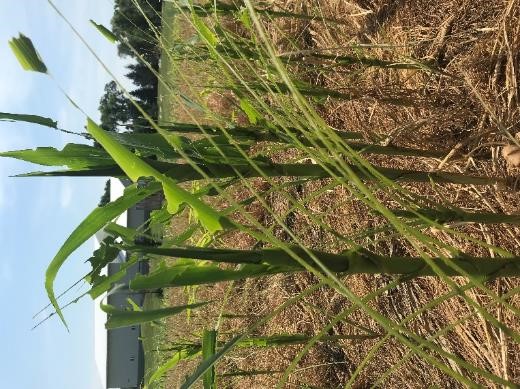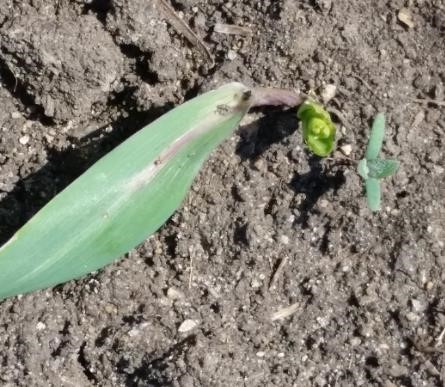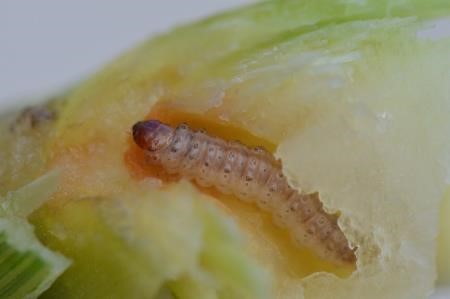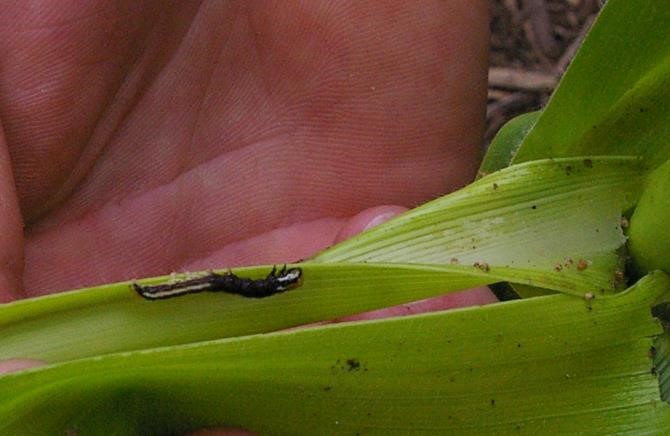4/24/2023 | Volume 26 issue 4
This newsletter and the advice herein are free. You usually get what you pay for.
Crop weather
Rainfall, air and soil temperatures, degree-days, soil moisture, and other current and historical weather data for the University of Minnesota Southwest Research and Outreach Center (SWROC), a little spot about two miles west of Lamberton, MN, can be found at https://swroc.cfans.umn.edu.
We had enough snowmelt and rain to raise soil moisture to near historical average. The results should be on the website soon.
After a brief preview of spring temperatures, it has reverted to a cold, slow spring. While the fields in southern Minnesota are now relatively snow-free (for now), there is still a bit of snow in parts of West Central. Central and Northeast Minnesota. Unfortunately, the forecast continues to show moisture and cold temperatures. While it’s not all bad because we need the moisture, the clay loam soils around here can be a sticky problem if worked. They are going to need warm-weather days before any fieldwork can commence.
In this issue, I’ll throw out a few of my thoughts on a few of the possible 2023 lepidopteran pests of corn. All but European corn borer have some potential to be associated with cover crops.
True Armyworms (TAW).
Armyworms were mentioned in a previous issue (2023-2).
TAW migrate into the state so each year’s risk to corn depends on numbers of moths migrating into an area and the availability of egg-laying sites in or near corn. Non-empirical observations indicate that economic infestations may be occurring more often in recent years. Here are some thoughts specific to corn.
- Migrating armyworm moths look for dense, lush grasses to lay their eggs. Cereal rye may be some of the first tall, green spring grass, and very attractive to egg-laying moths. As the spring progresses, dense stands of uncontrolled weedy grasses also become attractive.
- If you decide to plant corn into a rye cover crop, realize that

- it is a higher-risk production system with respect to TAW and several other corn insects.
- For several reasons, terminate rye as early as possible when corn is planted in the field. With respect to armyworms, late-terminated rye will be larger and more attractive to the egg-laying moths and for a longer period of moth immigration.
- Scout before and after cover crop termination and scout corn adjacent to rye for TAW. Fields not scouted can sustain rapid severe injury from late-stage TAW larvae (fig 1).
- Scout before making insecticide decisions to ensure larvae are still present and actively feeding.
- Before making an insecticide application to control armyworms, make sure they are still feeding.
- Once injury progresses as far as the field in the photo, any insecticide applications would be useful only to prevent armyworm movement to an adjacent field - or for revenge.
- Weather systems and populations of overwintering TAW moths to our south will determine 2023’s risk. Blacklight and pheromone traps will provide clues as to when and how many armyworm moths are moving through Minnesota in 2023.
- Bt toxins, except for Vip3A, have limited activity and are not marketed for TAW control. The Handy Bt Trait Table (2023) lists which traits have efficacy on TAW and other corn insects. It also provides information on which traits to which insects have developed.
- For more information on armyworms see https://extension.umn.edu/corn-pest-management/armyworm.
- Pheromone traps have captured very few TAW moths so far this spring.
Black cutworm (BCW)
Another corn pest that cannot survive Minnesota winters is the black cutworm. For the past several years, Minnesota farm families and their corn checkoff dollars have funded a pheromone trapping network to track the spring movement of black cutworm moths into MN. This network will be running, but at a somewhat reduced level, again this spring. Snow covered fields delayed deployment of the more northern BCW (and TAW) traps but soon we should have a migratory moth detection network that will rival the Maginot line in impenetrability.
If the trapping network detects any significant flights, alerts for when and where potential economic infestations could occur will show up in issues of SW MN IPM Stuff and Minnesota Crop News
- The pheromone traps will detect when moths arrive. Focus scouting on fields that were tilled and planted after moths arrive.
- Fields with a history of heavy-density winter annual (e.g., pennycress, shepherd’s purse) and early spring emerging (e.g., common lambsquarters) weed populations are attractive to egg-laying moths.
- BCW infestations are often found in low-lying areas. These

- are worth scouting.
- Several above-ground Bt traits have activity on BCW. Focus initial scouting on fields without these traits.
- BCW has a wider host range than TAW including broadleaf crops and weeds.
- Remember to look for leaf feeding and cut weed seedlings when scouting for weed control decisions.
- Remember there are other overwintering cutworm species that reduce corn stands.
- For more information on black cutworms see MN cooperative black cutworm reporting network
- BCW movement into Minnesota has been slow this spring. Only a single trap site has captured more than one or two moths.
European corn borer (ECB)
- Once competing with northern and western corn rootworms for the most troublesome insect pest of MN corn, ECB populations are now low, but they are not extinct.
- ECB larvae overwinter well in MN conditions.
- Single-generation (univoltine) and multiple-generation (multivoltine) ECB biotypes exist in MN.
- Bt-resistant ECB populations are not yet known in the U.S.

- Use light trap information and degree day predictions to time scouting efforts for larvae in non-Bt corn.
- Fields in areas with a longer-term history of ECB-susceptible hybrids are the most likely to see yield-limiting populations.
- Use corn stage to help target fields for scouting. 1st generation multivoltine moths choose the tallest whorl stage corn to lay eggs. 2nd generation seek later planted fields. Where differences are available, univoltine moths tend to lay eggs in corn closest to pollination.
- For more information on European corn borer see:
Common stalk borer
The female moth lays eggs in grasses, giant ragweed, and other plants in late summer into early fall with early-seeded rye being a potential site for egg-laying. After eggs hatch in the spring, larvae move to a host and tunnel into the stem. If the host is outgrown or killed, they will move to corn feeding in the whorl (figure 4) and tunneling in the stems. Small corn plants can be killed.
- Common stalk borer is a minor corn pest in MN, but certain

- fields tend to be prone to infestations.
- Infestations are often found on the border rows of corn fields with giant ragweed infestations.
- Focus your scouting and management efforts on hybrids without above-ground Bt traits.
- Insecticide applications would need to control larvae as they move to and tunnel into corn.
- Defoliation is the first sign of common stalk borer moving to corn. Larvae need to be controlled before they have tunneled into the stem and caused plants to wilt.
- Common stalk borer activity can be predicted with a degree day (DD) phenology model (Base 41o F accumulated from January 1). Eggs hatch between 575 and 750 DDs. Terminating weeds and grasses from 750 to 1299 DDs will force larvae to move to corn early. Scout the edges of cornfields for defoliation between 1300 and 1700 DDs.
Hop vine borer
This is another relatively rare MN corn pest that has also been found in corn planted into winter rye. Eggs are laid on grasses in the fall and hatch in the spring. Large larvae move to corn when they outgrow the grass stems in which they have been tunneling. Larvae attack corn at the base of the plant and kill the plant by tunneling into the growing point.
- Focus on fields where grass weeds were present the fall before. Early planted winter rye is a potential egg laying site.
- Wilting of small corn plants is usually the first sign of a hop vine borer infestation.
- Managing grasses is the best management option for fields with a history of hop vine borer.
- Rescue insecticides are not an option. Insecticides would have to be present and active during the short period when larvae moved to corn.
- We do not have a good way to predict hop vine borer populations other than a history of problems in the field.
Happy trails,
Bruce
